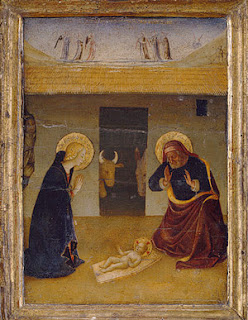
Only two things need to be said:
1. In eastern iconography the nativity takes place in a cave. That is, Christ is nurtured in the womb of the earth. This introduces and invites a very rich seam of symbolism, both in regards the nature of the Logos, and in regards the nature of the Virgin Mary. In western iconography, however, depictions of the nativity as having taken place in a stable came to predominate. This has various implications. For a start, let us note, a stable is a man-made structure, as opposed to a cave. Moreover, it gives the scene a strong social element, whereas the eastern type is more cosmological. In the west, the stable underlines the lowly social status of the holy family. The meaning of the stable is that Christ was born among the lowest of the low. In the west, the emphasis is less on the sociology of the scene and more on its cosmic significance.
2. Nothing illustrates the differing temperaments of the Catholic and the Eastern Orthodox versions of traditional Christianity than the contrast noted above (1). If you ask, what is the difference between the Catholics and the Orthodox you need only look at the following nativities. Historically, of course, the Orthodox remains focused upon a strictly traditional iconography - its icon tradition remains intact to this day. In Europe, the so-called Renaissance introduced a humanism that broke from the Byzantine icon tradition and, in effect, Western Christianity thereafter set out upon a very different journey.
It is not an accident that the Virgin is turned away from the Child. But it is a non-human gesture that worries the Western temperament which is less intellectual and more sentimental than the Eastern. Accordingly, Western iconography moves to the 'human' and sentimental plane, as we see in Giotto. Real people, real Mother/child, real emotions. The western (Catholic) temperament approves of this:
(For discussion, see here.)
Bernardo Daddi
Gentile de Fabriano. Alongside the humanistic and volumistic early Renaissance Giotto style there was also 'International Gothic'. This style emphasizes the magical and the mysterious. The darkness of the forest and the starry night - that is International Gothic. Note, in this painting by Gentile de Fabriano, the supernatural light source. The painting is lit by a divine light, not a natural light as in Giotto. This is a wonderful painting.

(Master of the Castello Nativity.)
Fra Angelico
Harper McAlpine Black













No comments:
Post a Comment